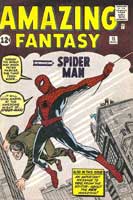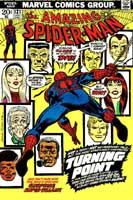| Action Reviews
|
Spider-man, 2002. Directed by Sam Raimi.
Tobey Maguire, Kirsten Dunst, Willem Defoe, James Franco, Rosemary Harris,
Cliff Robertson, J. K. Simons .
Synopsis: Peter Parker's life is complicated.
Once upon a time, he was a nice, normal kid, bookish and a bit of a
misfit, but a kid with family values. Peter lives with his doting Aunt
May and Uncle Ben. He has an unrequited crush on Mary Jane Watson, the
girl next door. One day, on a field trip to a science lab researching
spiders, Peter is bitten by a genetically engineered "super spider."
At first, it makes him sick, but when he awakens, his scrawny frame
has bulked up into something that might have been sculpted by Michaelangelo.
His vision has improved so that he no longer needs his glasses. And
he has new, strange powers: he can walk on walls, he has a preternatural
sense of danger, and he has developed spinnerettes on his wrists. At
first, Peter revels in his new abilities, running across the rooftops
of Queens with giddy abandon. Then he realizes that there might be some
money in his new abilities. He creates a primitive costume to hide his
identity and enters a wrestling contest as "The Amazing Spider-man."
The promoters of the contest cheat Peter of his winnings and when they
are robbed, Peter doesn't lift a hand to stop it. Unfortunately for
Peter, the robber car-jacks a getaway vehicle, a car driven by Peter's
Uncle Ben, leaving Ben Parker dead. This teaches Peter a bitter lesson:
with great power comes great responsibility. Upon graduating from high
school, Peter moves in with his best friend, Harry Osborne. Harry has
problems, too. His industrialist father, Norman Osborne, is going insane,
having subjected himself to an untried process designed to create a
super soldier for the military. His personality has split down the middle,
and the murderous, paranoid half of his psyche manifests itself as The
Green Goblin. Spider-Man and The Green Goblin seem to be on a collision
course... Amazing Fantasy: Spider-man's creator,
Stan Lee, had a great epiphany in the early 1960s. What if, he thought,
superheroes had the same problems that ordinary people had. He first
implemented this idea in The Fantastic Four (conceived to cash in on
the success of the Justice League of America over at "the distinguished
competition"). The Fantastic Four was quickly commandeered by its
artist, the great Jack Kirby, who transformed it into grand opera during
the course of his run on the book--Lee may have been credited as the
writer, but the book was Kirby's. Following The Fantastic Four's success,
Lee embarked on one of the great creative spurts in comics, creating
just about the entire line-up of Marvel Comics (mainly in collaboration
with Jack Kirby). It was Lee's third creation for the fledgling Marvel
line-up--Spider-man--that distilled his innovation to its purest incarnation.
Lee didn't like Kirby's take on Spider-man and handed the art duties
on this new creation to Steve Ditko. Even though Ditko did some of his
best work on the early Spider-man comics, the book remained Lee's principal
outlet for the revolution he hoped to create in comics. Spider-man,
even more than Lee's previous creations, is Everyman. He broke all the
rules. He wasn't some adult hero's teen-sidekick, despite being a teenager
himself. He had no great desire to fight crime. He wasn't just disguised
as a mild-mannered nobody: he WAS a mild-mannered nobody. And all of
what Spider-man would become can be found in the fifteen page origin
story that ran in the final issue of Amazing Fantasy. This story, which
provides the first half of the new film version of the character, is
a stark morality play in which Peter Parker gets bitten by the spider,
tries to make it in show business only to discover that the bank won't
cash a check made out the "Spider-man," and fails to save
his Uncle Ben, thus learning that "with great power comes great
responsibility." Parker's essential masochism finds its genesis
in this story, and would later manifest itself in deranged instances
of self-pity as Parker shoulders the responsibilities of the world. Oddly enough, most of this makes it into the movie. Spider-man's origin story is left in the movie practically
verbatim (although some of the details are changed slightly). Peter
Parker's pathological need for expiation makes it into the film too.
Director Sam Raimi and company largely do right by the character and
the film is a marvelously conceived entertainment. But it's not perfect
by any means. Performances: The casting for this movie is letter perfect. A better choice for Peter Parker than Tobey Maguire would be difficult to imagine, and his cast of supporting characters, from girl-next-door Mary Jane Watson (Kirsten Dunst) to poor little rich kid Harry Osborne (James Franco) to kindly Aunt May (Rosemary Harris) to wise Uncle Ben (Cliff Robertson) shows more attention to character than to box office than one would expect from a hundred million dollar blockbuster. Of special note is J. K. Simons as prickly newspaper editor J. Jonah Jameson, who has a scant five minutes of screen time, but never the less walks off with the movie ("Slander! I resent that, Parker! If I publish it, it's LIBEL, not slander!"). Only Willem Defoe seems out of sorts in this mix. He's an obvious choice for a deranged lunatic and, to his credit, he underplays the Green Goblin's alter-ego, Norman Osborne, marvellously. AS the Green Goblin, he's trapped inside a bad costume that looks to have been stolen from the set of some dumb Japanese kiddie show and is given dialogue like, "You've spun your last web, Spider-man." The Green Goblin part of the movie is particularly troubling, given that the origin story from Amazing Fantasy #15 actually has everything that the movie needs (although trying to convince a film executive that a superhero doesn't actually NEED a supervillain might be a problem). In directing the movie, Raimi's hand is most evident
in the casting. In addition to the major characters, Raimi has given
bit parts in the film to his friends (Bruce Campbell shows up as a wrestling
promoter, Lucy Lawless is a punk rock chick on the street, Ted Raimi
works for the Daily Bugle, etc.). Raimi is NOT in evidence as a director
here, though. The Raimi of old never saw a dutch tilt he didn't like,
never saw a way of moving the camera he didn't want to try, and never
saw a way of giving the audience a thrill that he wouldn't go out of
his way to attempt. The Raimi who directed THIS film, however, is anonymous.
The direction is flat and the opportunities presented for visual flash
are largely ignored (a POV shot of what it's like to swing through the
canyons of New York, anyone?). The film is grounded by its script to
its own detriment. Also to the film's detriment: the CGI effects never
look like anything but CGI effects. The characters involved in these
sequences look like they escaped from a video game. They fail to convince.
Ah...the script. Here's where Spider-man begins to get into trouble. There are niggling little inconsistencies in the script that begin to add up over time. Why, for instance, does Peter's "spider sense" work flawlessly when mere humans are throwing punches at him but not when the Green Goblin is throwing punches at him. Why do the police show no interest in Norman Osborne as a suspect in the deaths of his board of directors, even though he is the person who benefitted most from their deaths? And why does Peter Parker blow off Mary Jane at the end of the movie after pining for her for the film's entire length? This last part is instructive, though. It DOES point to Parker's essential masochism. The scene, as played, makes one wonder why Mary Jane doesn't come right out and ask Peter if he's gay, although it also hints that she knows Peter's true secret. |
|
Still and all, the film approaches the character and the world he inhabits with a modicum of respect, and finds its best moments in its characters rather than its set pieces and involves the audience in the human beings on the screen rather than state of the art special effects. And how many summer blockbusters can make THAT claim? Not many, that's for sure... |

